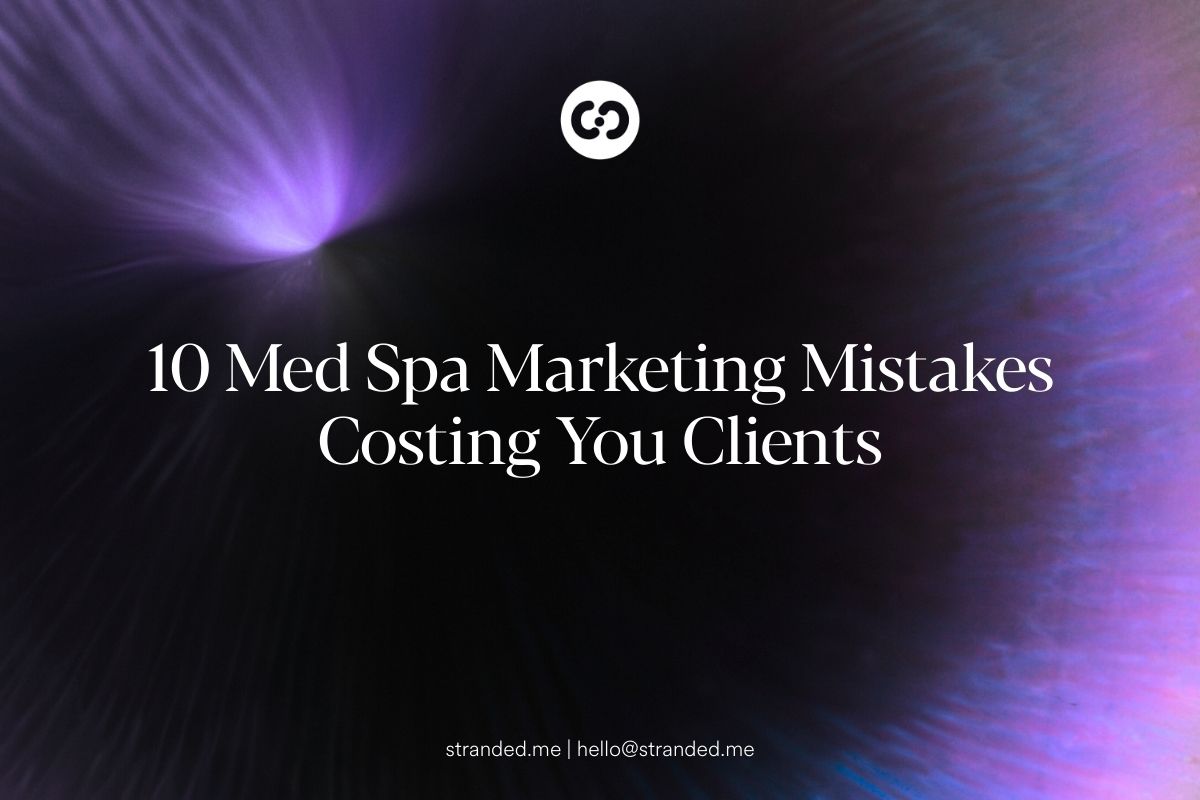10 Med Spa Marketing Mistakes That Are Costing You Clients
July 30, 2025 · Min Read

© Stranded
Growing a med spa in today’s competitive market requires more than high-quality treatments—it demands a marketing strategy that drives awareness, trust, and bookings. Unfortunately, many practices fall into avoidable traps that stall growth and waste budget. In fact, 76% of consumers look at a business’s online presence before visiting in person, meaning your marketing performance directly impacts your bottom line (source). In this article, we’ll break down the most common med spa marketing mistakes and show you how to avoid them so you can attract more clients, improve local visibility, and increase revenue.
In this article, we’ll break down the most common med spa marketing mistakes and show you how to avoid them so you can attract more clients, improve local visibility, and increase revenue. If you want to explore tailored strategies for your practice, visit our Med Spa Marketing page for in-depth solutions that get results.
If your med spa doesn’t appear in local search or Google Maps, you’re missing out on clients who are ready to book. Optimize your Google Business Profile with accurate service listings, fresh photos, and positive reviews. Add location-specific pages to your site so you show up when people search for treatments in your area.
Social media is great for visibility, but it’s not a complete client acquisition strategy. Pair your Instagram content with pay-per-click ads and search engine optimization to reach people actively searching for services like Botox, fillers, or laser treatments.
Running campaigns without tracking performance is like flying blind. Use Google Analytics, call tracking, and CRM software to connect marketing activity with real bookings and revenue. Set measurable goals for every campaign.
People who have already visited your website or clicked an ad are more likely to book. Retarget them with Google or Facebook ads to keep your med spa top of mind until they’re ready to commit.
A beautiful med spa doesn’t matter if your website is slow or confusing. Ensure your site loads quickly, is mobile-friendly, and makes booking an appointment simple. Prominent “Book Now” buttons can make a big difference.
Potential clients want proof that your treatments work. Publish before-and-after photos, client testimonials, and success stories. This builds trust and improves your search engine rankings.
Random discounts attract deal hunters, not loyal clients. Instead, run time-limited promos tied to holidays, events, or package upgrades. Be sure every offer includes clear value—and a measurable goal.
Email is still one of the highest-ROI marketing tools for med spas. Send monthly newsletters with special offers, treatment spotlights, or skincare tips. Use segmentation to make your emails more relevant based on client history or interests.
Different services peak at different times of the year. If you’re not adjusting your marketing calendar for seasonal demand—such as promoting body contouring in spring or laser hair removal before summer—you’re missing revenue opportunities.
Your marketing can bring in inquiries, but if your front desk team isn’t trained to convert them into bookings, you lose potential revenue. Provide scripts, objection handling, and follow-up processes to turn leads into paying clients.
Every marketing tactic should bring you closer to your goals—whether that’s more bookings, better client retention, or stronger local authority. Avoid these ten mistakes, and you’ll position your med spa for growth in a competitive market.
Avoiding these marketing mistakes is just the first step. The next is putting a proven strategy in place that attracts high-value clients, builds lasting trust, and keeps your appointment calendar full. At Stranded, we specialize in creating data-driven campaigns that combine local SEO, paid ads, content marketing, and retention strategies tailored to your practice.
Schedule a Free Strategy Call Today
Frequently Asked Questions About Med Spa Marketing
To attract more clients, focus on visibility and trust. Optimize your Google Business Profile, run targeted Google Ads, and create educational content that positions your med spa as an authority. Pair these with a strong retargeting campaign and an email marketing strategy to re-engage past visitors.
One of the biggest mistakes is relying solely on Instagram or other social platforms for client acquisition. While social media builds awareness, search-based channels like Google Ads and local SEO reach people actively looking to book treatments now.
Most successful med spas invest between 5% and 10% of their annual revenue into marketing. The exact amount depends on your goals, local competition, and service pricing. Consistency matters more than one-time big spends.
A combination of Google Ads, local SEO, and targeted social media ads works best. Google Ads capture high-intent searches like “lip filler near me,” while social platforms build brand awareness and retarget interested prospects.
Yes. Email is one of the highest-ROI marketing channels for med spas. By segmenting your list based on treatments, past purchases, or birthdays, you can deliver highly relevant offers that drive repeat bookings.
Track every campaign’s performance with Google Analytics, call tracking, and CRM data. Use A/B testing for ads and landing pages, and focus on channels that produce measurable results over time.